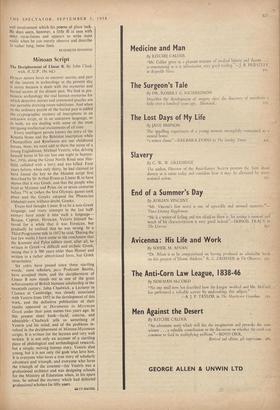Minoan Script
The Decipherment.of Linear B. By John Chad- wick, (C.U.P., 18s. 6d.) HUMAN nature loves to uncover secrets, and part of the interest in archaeology at the present day is surely because it deals with the mysteries and buried secrets of the distant past. We find in pre- historic archaeology the real human mysteries for which detective stories and crossword puzzles are our portable drawing-room substitutes. And when to the ordinary puzzle of the buried past is added the cryptographic mystery of inscriptions in an unknown script, or in an unknown language, or in both, we are dealing with some of the most intriguing intellectual excitements of all time.
Every intelligent person knows the story of the Rosetta Stone and the Behistun inscription while Champollion and Rawlinson are our childhood heroes. Now, we must add to them the name of a young Englishman, Michael Ventris, who, driving himself home in his car late one night in Septem- ber, 1956, along the Great North Road near Hat- field, collided with a lorry and was killed. Four Years before, when only thirty, he had claimed to have found the key to the Minoan script first described by Sir Arthur Evans as Linear B, to have shown that it was Greek, and that the people who lived at Mycente and Pylos six to seven centuries before 776 BC (when the first Olympic games took place and the Greeks adopted the Phoenician alphabet) were, without doubt, Greeks.
Evans had thought Linear B to be a non-Greek language, and many attempts in the last half- century have made it into such a language— Basque. Cypriot, Etruscan. Ventris hithself be- lieved for a while that it was Etruscan, but gradually he realised that he was wrong. In a Third Programme talk in 1952 he said, 'During the last few weeks I have come to the conclusion that the Knossos and Pylos tablets must, after all, be written in Greek—a difficult and archaic Greek,- seeing that it is 500 years older than Homei and written in a rather abbreviated form, but Greek nevertheless.'
Six years have passed since those startling words: most scholars, pace Professor Beattie, have accepted them, and the decipherment of Linear B now stands out as one of the great achievements of British humane scholarship in the twentieth' century. John Chadwick, a Lecturer in Classics at Cambridge, was closely associated with Ventris from 1952 in the development of this work, and the definitive publication of their results appeared as Documents in Mycenean Greek under their joint names two'years ago. In this present short book—lucid, concise, and admirable—Chadwick tells us something of Ventris and his mind, and of the problems in- volved in the decipherment of Minoan-Mycenean scripts. It is written for the layman and very well written. it is not only an account of a startling piece of philological and archaeological research, but a simple, moving human story. Ventris died young, but it is not only the gods who love him. It is everyone who loves a true story of scholarly adventure and triumph, and everyone who loves the triumph of the amateur—for Ventris was a professional architect and was designing schools for the Ministry of Education wheh, in his spare time, he solved the mystery which had defeated
professional scholars for fifty years. •
GLYN DANIEL


































 Previous page
Previous page